Gobos are an integral part of professional show lights. A gobo is a type of mask in the form of a glass disc that is placed in front of a light source to project logos, images, or text onto a surface. Instead of gobos, show lasers use its scanning system to display shapes and figures. Furthermore, these figures can be animated and displayed simultaneously in multiple colours.
If you find a mistake or if you have suggestions for additional terms, please drop an E-Mail to [email protected]
Glossary - Terms and DefinitionsGlossary - Terms and Definitions
What is a Graphics Show?
Laser shows may either be designed as graphics or as beam shows. Beam shows project the laser beams into the room, while graphics shows use projection surfaces in order to display laser graphics, patterns, animations, etc. Such projection surfaces may be gauze, water or fog screens, hydro shields, frosted glass, walls, buildings and natural surfaces, as rocks, mountains, etc.
Which show laser is the best for graphics shows?
For displaying a graphics show, you'll need a show laser with scanning system fast enough for your animations. The fast the scanner, the clearer and more detailled the picture, graphic or animation gets.
If you want to create and project your very own graphics show, a show laser light with ILDA connection is needed. Furthermore you'll need a professional show laser programming software. Laser displays with just a DMX connection are only able to display graphics that were pre-programmed on the laser projector.
When planning an outdoor graphics show, a particularly powerful laser system with low divergence will suit best. With this setup a precise beam over long distances is guaranteed.
Laserworld offers high-end solutions as well as more budget versions like the EL-500RGB KeyTex with its keyboard for fast text and graphics creation.
#Animation Laser
Laserworld_CS-1000RGB_MKII_Graphics-03.jpg
https://www.laserworld.com/images/Animations/Laserworld_CS-1000RGB_MKII_Graphics-03.jpg
Laserworld_PL-20000RGB_graphics-001.jpg
https://www.laserworld.com/images/Animations/Laserworld_PL-20000RGB_graphics-001.jpg
Laserworld_CS-1000RGB_MKII_Graphics-04.jpg
https://www.laserworld.com/images/Animations/Laserworld_CS-1000RGB_MKII_Graphics-04.jpg
Laserworld_Proline_Series_Graphics-0020_web.jpg
https://www.laserworld.com/images/Animations/Laserworld_Proline_Series_Graphics-0020_web.jpg
Laserworld_Diode_Series_Graphics-0006.jpg
https://www.laserworld.com/images/Animations/Laserworld_Diode_Series_Graphics-0006.jpg
Laserworld_Diode_Series_Graphics-0005.jpg
https://www.laserworld.com/images/Animations/Laserworld_Diode_Series_Graphics-0005.jpg
Laserworld_EL-500RGB_KeyTEX-0003.jpg
https://www.laserworld.com/images/Animations/Laserworld_EL-500RGB_KeyTEX-0003.jpg
Laserworld_Diode_Series_Graphics-0040.jpg
https://www.laserworld.com/images/Animations/Laserworld_Diode_Series_Graphics-0040.jpg
Tarm_Series_tarm_four_seven_graphics_1_web.jpg
https://www.laserworld.com/images/Animations/Tarm_Series_tarm_four_seven_graphics_1_web.jpg
Laserworld_PL-20000RGB_graphics-002.jpg
https://www.laserworld.com/images/Animations/Laserworld_PL-20000RGB_graphics-002.jpg
Laserworld_Proline_Series_Graphics-0013_web.jpg
https://www.laserworld.com/images/Animations/Laserworld_Proline_Series_Graphics-0013_web.jpg
tarm-two-graphics-007.jpg
https://www.laserworld.com/images/Animations/tarm-two-graphics-007.jpg
See >>>scanner>>>
What is a Gauze Screen?
The term "gauze" denotes a thin textile material which has got many very small holes similar to a fishnet. A gauze screen is used to project laser graphics, texts, etc. on it in order to make them visible. It is suitable for projections beamed at the forefront of the screen, so called "front projections", but also for projections on its rear side, "rear projections".
The term "mesh screen" is used as a synonym for "gauze screen".
Picture of a Gauze Screen (right side)
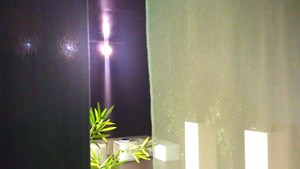
Further information on Laser Screens
What is a Hydro Shield?
As well as water screens hydro shields are projection surfaces made of water used to make laser graphics and effects visible. But contrary to water screens, where water drops fall down from above, hydro shields emerge semicircular from the bottom upwards. They consist of a special 180° flat nozzle together with a very strong pump system. It is essential to have a permanent water source, therefore the nozzle may be placed in a lake or the like. Hydro shields are often used for rear projections and are able to disappear within seconds - an advantage over other kinds of screens.
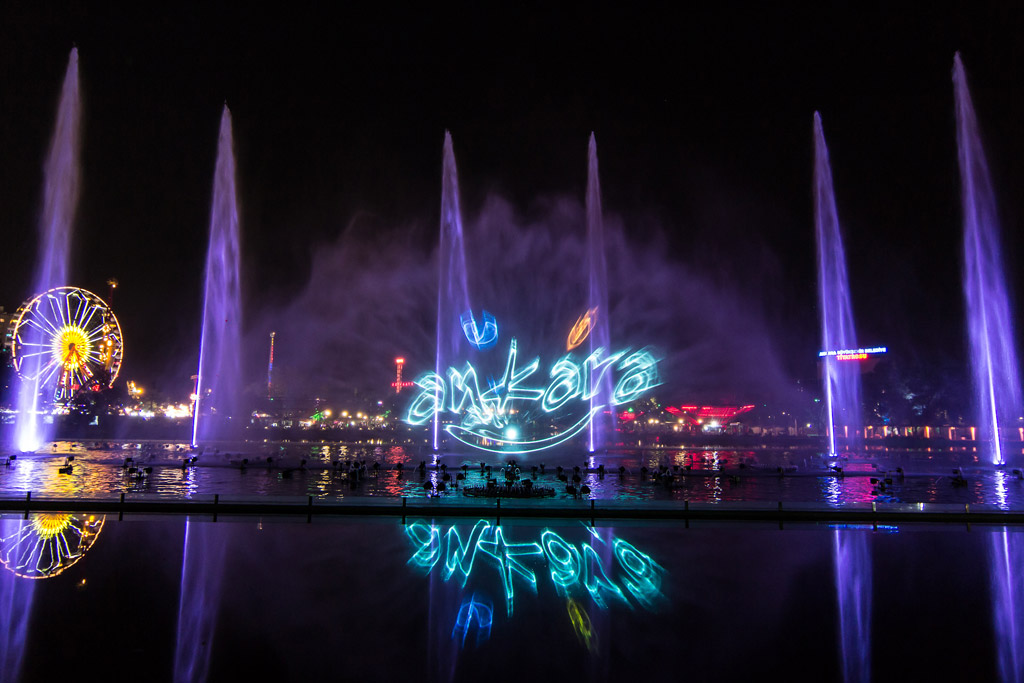
Further information on Hydro Shield
The ILDA signal comes from a random DAC (e.g. FB3, Phoenix USB, etc.) and is feeded with a short ILDA cable to the sender. The sender transforms the signal to a digital network protiocoll and streams it to the network. The receiver gets the signal that was specified for it and transforms it back to the analog ILDA signal.
The advantage is, that the possible transmission distances of network signals is very long and network cables are easily available all over the world. ILDA cables are rather limited in their maximum possible length, so the physical limits are quickly reached at large scale productions. ILDA streaming is a good and stable option to easily extend the signal transmission distances. This method has been explicitly developed for show laser light applications, so it is superior to USB->LAN converters if it comes to laser applications.
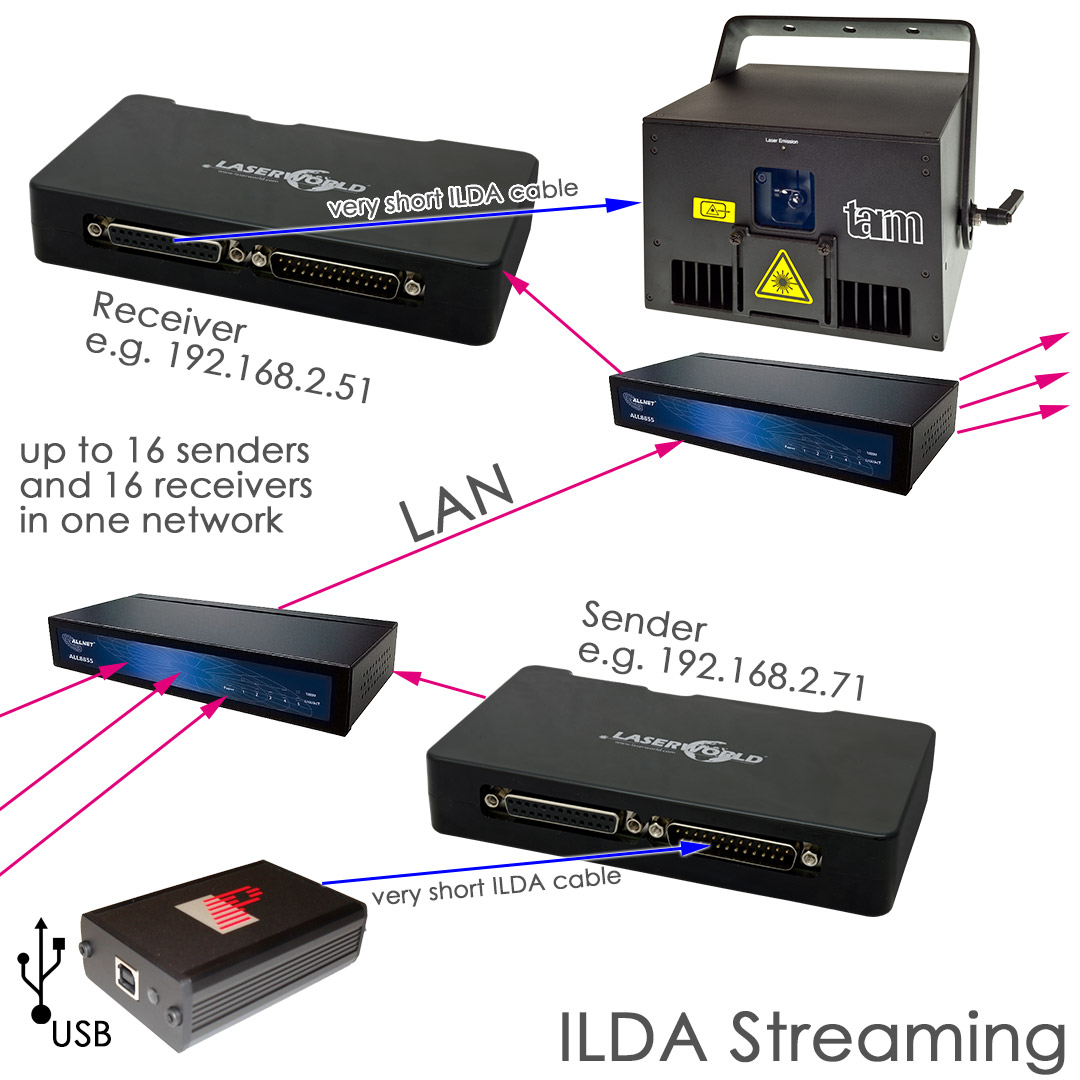
The most common ILDA streaming hardware solution is the Laserworld ShowNET interface.
What is an ILDA connector?
ILDA describes a data transmission protocol developed by the International Laser Disyplay Association for transferring image data between laser control systems and laser projectors. An ILDA connector is the standard connector for show laser lights to connect the laser display with an ILDA cable to the laser control device.
The connector is a 25 pin DB-25 connector:

| Pin 1 | x-axis scanner, positive signal. Difference of 10V |
| Pin 2 | y-axis scanner, positive signal. Difference of 10V |
| Pin 3 | intensity/brightness, positive signal. Difference of 5V |
| Pins 4 and 17 | Interlock. Linking of both enables output |
| Pin 5 | red intensity, positive signal. Difference of 5V |
| Pin 6 | green intensity, positive signal. Difference of 5V |
| Pin 7 | blue intensity, positive signal. Difference of 5V |
| Pin 8 | deep blue intensity, positive signal. Difference of 5V |
| Pin 9 | yellow intensity, positive signal. Difference of 5V |
| Pin 10 | cyan intensity, positive signal. Difference of 5V OR: DMX512 IN; positive signal (Showeditor, Showcontroller, ShowNET and Phoenix interfaces). |
| Pin 11 | DMX512 OUT; positive signal (Showeditor, Showcontroller, ShowNET and Phoenix interfaces). |
| Pin 12 | Projector return signal |
| Pin 13 | Shutter. Difference of 5V |
| Pin 14 | x-axis scanner, negative signal. Difference of 10V |
| Pin 15 | y-axis scanner, negative signal. Difference of 10V |
| Pin 16 | intensity/brightness, negative signal. Difference of 5V |
| Pins 17 and 4 | Interlock. Linking of both enables output |
| Pin 18 | red intensity, negative signal. Difference of 5V |
| Pin 19 | green intensity, negative signal. Difference of 5V |
| Pin 20 | blue intensity, negative signal. Difference of 5V |
| Pin 21 | deep blue intensity, negative signal. Difference of 5V |
| Pin 22 | yellow intensity, negative signal. Difference of 5V |
| Pin 23 | cyan intensity, negative signal. Difference of 5V OR: DMX512 IN; negative signal (Showeditor, Showcontroller, ShowNET and Phoenix interfaces) |
| Pin 24 | DMX512 OUT; negative signal (Showeditor, Showcontroller, ShowNET and Phoenix interfaces). |
| Pin 25 | Ground |
International Laser Display Association is the long version for ILDA. >>>See here: ILDA>>>
More information on ILDA
What does ILDA stand for?
ILDA is the abbreviation of "International Laser Display Association" and thus the name of an association of laserists. It also describes a signal transmission protocol for the computer control of show laser light systems.
Example of a show laser ILDA connection
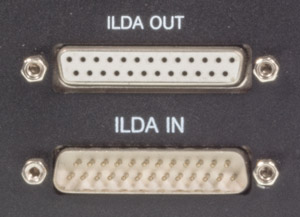
How is a Laser System with ILDA connection controlled?
The ILDA laser control signal uses a parallel transmission whereas the computer control signal is serial. That's why the computer control signal has to be convertered to ILDA by a Digital Analogue Converter (DAC), also called "ILDA Interface", combined with laser software. For individual control of multiple laser systems it is necessary to use several DACs (one per individually controlled laser). The ILDA control signal uses a very dense transmission structure, as it has to control every single color change and every re-positioning of the scanners, that it has a 1:1 relation to the laser system. There is no "addressing" possible, like with DMX512 (which works completely different, as the DMX protocol only transmits low-level information).
The creation of logos, texts and animations is only possible due to the complex control structure of a laser. DMX requires the intelligence to be built-in to the DMX fixture - the ILDA signal is capable to real-time transmit the "intelligence" to the laser system.
ILDA control over long distances
Modern show laser light software uses LAN transmission of the ILDA control signal and only converts the serial LAN signal to the analog ILDA signal directly at the laser projector. The limitations of analog transmission technology can be overcome with this and very long transmission distances become possible.
What is the best ILDA laser?
There is no such thing like the best show laser system. There is only the best laser display for your purpose. And this depends on many factors: How big is your venue? Do you need graphics projections? Is it a multimedia show with water involved? Is it an outdoor show or in broad daylight?
Laserworld offers many laser lights and only the smallest budget ones don't have an ILDA connection but DMX or automatic modes.
Laserworld offers a tool for helping you to find your desired show laser system: Find Your Laser
More information on ILDA
What does ILDA stand for?
ILDA is the abbreviation of "International Laser Display Association" and thus the name of an association of laserists. It also describes a signal transmission protocol for the computer control of show laser light systems.
International Laser Display Association
ILDA was founded in 1986 as a worldwide non-profit organization to improve and increase the usage of laser lights. The members of ILDA are mainly laser show hosts and show laser distributors / sellers.
One of the many benefits from being an ILDA member are the annual ILDA Awards. Artistic, Technical and Career Achivement Awards are given and can also be used for marketing purposes.
ILDA control
The ILDA developed a technology for interchaning image data (as *.ild-files) between laser controlling systems and the laser display. Most entertainment lasers come with an ILDA connection to transfer these data. Nowadays it is the most common way to create laser shows and display them with show laser lights.
What is an ILDA cable?
ILDA is a data transmission technology developed by the International Laser Display Association for interchanging image data between laser control systems and show laser lights. The ILDA cable connects the laser display with the controlling device.
What is the maximum length of an ILDA cable?
What means ILDA projector?
ILDA is the abbreviation of "International Laser Display Association", a non-profit organization to increase and expand the use of show laser light systems. This association developed a data transmission protocol to transfer image data between a show laser control device and the show laser system. Every laser display with an ILDA connector is called ILDA projector and can be controlled via ILDA.
How does the ILDA control work?
As the ILDA laser control signal relies on parallel transmission and the computer control signal uses serial transmission, the computer control signal has to be converted to ILDA. For doing so you'll need a Digital Analogue Converter (DAC) which is often called ILDA interface.
The best ILDA projector
There is no such thing like the best ILDA projector. There is only the best laser display for your purpose. And this depends on many factors: How big is your venue? Do you need graphics projections? Is it a multimedia show with water involved? Is it an outdoor show or in broad daylight?
Laserworld offers many laser lights and only the smallest budget ones don't have an ILDA connection but DMX or automatic modes.



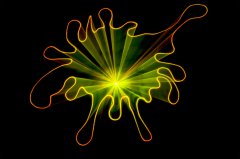
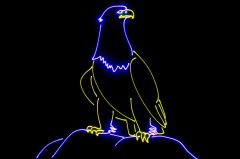
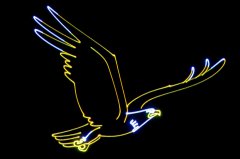
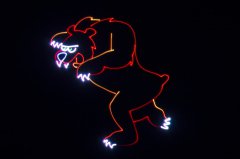

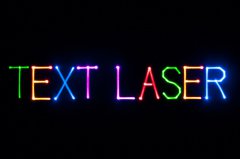
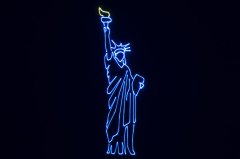


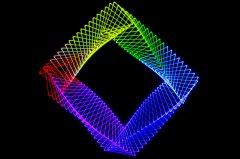
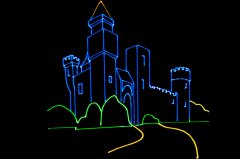
Distributed brands: